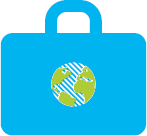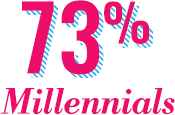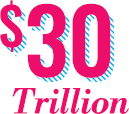
“Use purpose to prove to young consumers
that your values align with theirs.”
Part Two: Chapter 10
Unlock New Customers
By Marc Kielburger
Millennials, Gen Z, and Gen WE, oh my!
It was the end of an era in Canada. The Royal Canadian Mint was phasing out the one-cent coin. A single penny is a rounding error, the reason lone coppers are found abandoned on sidewalks or loose in junk drawers. But what about all of the pennies still in circulation? Our 2013 WE Create Change campaign encouraged Canadian kids to collect endangered pennies for clean water projects in WE Villages overseas. Who wouldn't offer their last few pennies to dig boreholes and build wells in developing communities? The coins were about to become extinct. But there was a small snag in our plan. We envisioned millions of pennies pouring into our offices. Who would count them? Who would roll them into those finicky little paper tubes for processing? For that matter, who would process them? And finally, who would accept pennies as payment and turn them into real money? The coins were about to become worthless.
Small change can make a big impact! Watch the campaign video: Click for video.
Enter the Royal Bank of Canada (RBC), the country's largest bank for much of modern history, and among the top fifteen banks in the world. Like any business, it couldn't be guaranteed that plum position in the future. Competition for banking customers is intense. More than four million Canadians swapped their financial partner between 2010 and 2015 and 70 percent said switching was simple.1
Customers today are less loyal to brands and services, and they have very high expectations. They want everything on their smartphones, instant digital transactions, longer branch hours, and they don't want to pay for their accounts. What's more, convincing the junior wedge of the demographic pie to choose a particular bank is incredibly tough. Young people are especially cynical about financial institutions, thanks to a global recession that, in the U.S., was largely blamed on Wall Street and big banks. (Canadian banks fared far better than most anywhere in the world, but that was a minor matter in the news during the Occupy movement.) This is why new checking accounts often come with free TVs or other electronic toys as enticements. What's more, technology has opened the fiercely competitive financial sector to new, nimble players like pay services from Apple and Google. Some big banks fear these are Trojan horses that will bring interference from more tech giants. When you can walk into a grocery store and walk out with a credit card and a car loan from its financial services partner, then, suffice it to say, the market is crowded. It's a tough time to be a bank. And critics are harsh. Canadian banks are not meeting the expectations of 75 percent of their customers, according to a survey by financial technology firm, FIS. In fact, Canadian consumers are among the most likely to shop around for financial services.2
RBC was well aware of these challenges when they partnered with us. They also knew that gaining access to future investors from a notoriously skeptical and well-educated generation would mean transparency and authenticity in these efforts. Customer engagement was a big bonus that year when the bank processed CND$1.4 million in donated pennies for WE Create Change. Allow me to move the decimal. That's 140,000,000 pennies, enough to outweigh five Boeing 747s—passenger jets always make numbers easier to digest. The feat is made even more incredible when you consider that kids ran the show, excavating couches at home and holding coin drives at school.
But there is one thing kids can't do—drive. And pennies are heavy. Across the country, proud parents walked into RBC branches with their kids, who hoisted bags of coins onto bank counters. Children and teens, rarely seen inside brick-and-mortar financial institutions, were welcomed like activist rock stars.
Teen participants in our RBC programs were surveyed, and are twice as likely to believe that RBC positively impacts their communities compared to other adolescents. They are also 1.3 times more likely to recommend the bank to friends and family.
“We have made a long-standing commitment to invest in and support youth— not only for their own benefit, but for the collective benefit of our local communities and the world.”
—Dave McKay, President and CEO of RBC
Because of WE Create Change alone, RBC had a boost of 55,000 unique customer walk-ins. That's 55,000 interactions with customer service reps, 55,000 pairs of eyes locked on in-branch advertising for the duration of their visit. More importantly, the cause of clean drinking water was aligned with RBC's Blue Water Project, which supports organizations that protect fresh watersheds, reduce water usage, and facilitate clean drinking water. Because RBC helped us with a logistical hurdle that we couldn't possibly have done in-house—processing millions of loose coins—more than 56,000 people received a sustainable source of clean drinking water, with wells dug and pump systems installed, community members trained in maintenance and repairs, and small businesses established to generate funds for any future repairs and expansion. Clean water scarcity still affects almost 40 percent of the global population, creating a host of sanitary and disease concerns. But clean water also has an economic benefit. The United Nations estimates that every US$1 invested in clean water translates into an average return of US$9, with those benefits being experienced specifically by poor children in disadvantaged communities.3 Canadian kids rolled up their sleeves to help impoverished children they'd likely never meet.
All of that social impact delivered, and scores of beaming parents watched their children give back while standing in line at the bank, not queuing for mortgage advice or currency exchange, but for purpose. In fact, they did more than just watch. One in four parents whose children participated in WE programming used an RBC banking service as a result of the partnership.4
You can almost see RBC's brand halo glowing, its customer base swelling. RBC has also supported financial literacy education in our WE Schools curriculum. The bank's “It All Adds Up” program encourages youth to save, spend, and donate, demonstrating that smart money management and giving back go hand in hand. This commitment to financial literacy for students—in other words, an investment in purpose—has nabbed attention from youth. In a focus group, WE Schools educators said the program has kids and teens thinking smarter about spending. One high school math teacher said, “Students are now starting to save for college. A group who were fundraising were able to better understand the impact of dollars raised.”
How will it all add up? Learn more: Click for video.
“Philanthropy can often be the most cost-effective way for a company to improve its competitive context.”
—Michael E. Porter, Professor at Harvard Business School
Marketing experts suggest that brand consciousness, the ability to recognize a product as distinct from others, starts when children are about 24 months old.
If you don't know much about industry marketing, it might seem pointless to win over teens who lack stable paychecks or stock portfolios. But today's teen is tomorrow's investor and easily becomes a lifelong customer.
As early as 36 months, children are aware that brands are meant to reflect personal attributes (cool, smart, sporty), learning most of their brand associations from mom and dad.5 Any parent walking through a grocery store can attest to the consequences of this research. It's no accident that cereal and cookies are stocked at a toddler's eye level. My daughters will reach out for a box from inside the confines of the shopping cart as if they are about to be reunited with a long-lost love, the aluminum chariot a cruel cage. What's actually in the box is of no consequence, as SpongeBob SquarePants stares out at them expectantly.
Purpose Unlocks New Customers.
“There is a spiritual aspect to our lives—when we give, we receive—when a business does something good for somebody, that somebody feels good about them!”
—Ben Cohen, Co-founder, Ben & Jerry's
The under-25s spend about £5 billion annually in the UK, with an increasing amount of disposable income. Pocket money for youth has reached an average of £6.84 per week, an increase of 500 percent compared to rates in 1987.6
In America, teens earn an annual income of $91 billion collectively, but are responsible for approximately $259 billion in spending. Clearly, they are living beyond their means, with a discrepancy covered by the Bank of Mom and Dad, making teens persuasive influencers in household buying habits overall.7 Figuring out what they want is quite lucrative.
This is not a generation lured by marketing gimmicks or confined by brand loyalty over the long term, says our friend David Stillman, co-author (with his teenage son Jonah) of Gen Z @ Work: How the Next Generation Is Transforming the Workplace. He tells us that for this cohort, the oldest of whom are now entering their twenties, purpose has become a given. “Just like we saw with millennials, Gen Z loves to make purchases that have an impact. However, where millennials accepted this as common practice, Gen Z expects it,” says Stillman.8
If this trend continues, future generations will be shopping for world change and scrutinizing corporate causes more thoroughly. Use purpose to prove to young consumers that your values align with theirs; that you care about the world they live in and issues that concern them. Purpose can grab this demographic and their disposable spending habits, and channel its buying power into bettering the world, while creating lifelong consumers for socially conscious companies.
Believe it or Not, Millennials are Worth Billions
A $12 Trillion Market is Opening: Are you Ready to Unlock the Customers?
In 2015, more than 150 world leaders adopted the United Nations Sustainable Development Goals, 17 concrete steps to change the world over the next 15 years. The ambitious plan includes actions to end poverty, hunger, and inequality, and to improve global access to health care and education. Delivering this social impact will also be quite lucrative.
One report estimates that sustainable business models related to the goals will create US$12 trillion in economic opportunities, and add 380 million jobs by 2030.11 That adds up to a whole lot of potential new customers.



